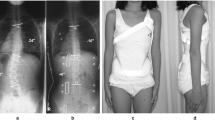Abstract
Background
Adolescent idiopathic scoliosis (AIS) is the most prevalent spine deformity within the pediatric population. Orthosis is the mainstay of conservative treatment for mild to moderate AIS. The Rigo System Chêneau (RSC) brace is a custom-made thoracolumbar sacral orthosis (TLSO) based on a three-dimensional correction concept. The purpose of this study was to identify factors that could predict the therapeutic success/failure of the RSC brace.
Materials and methods
A retrospective cohort study was performed on all consecutive patients according to the Scoliosis Research Society (SRS) criteria for the success of conservative treatment. Participants had a 2-year follow-up beyond the termination of brace treatment. All patients were treated with the RSC orthotic device.
Results
Ninety-three patients met the inclusion criteria. At treatment onset, their average age was 12.9 years, average Cobb angle 31.97°, Risser score 1.07, and the mean angle of thoracic rotation (ATR) was 10.2°. The mean brace treatment period was 36 months. Treatment was successful in 83.8 % of these patients (n = 79). The average final Cobb angle was 28.97°, Risser score 4.88, and ATR 8.09°. The pre-treatment factors associated with the success of applying the RSC brace were a high Risser score [odds ratio (OR) = 2.97, 95 % confidence interval [CI] 1.18–7.44; p = 0.02), a low Cobb angle (OR = 0.92, 95 % CI 0.85–0.99; p = 0.02), and low ATR (OR = 0.86, 95 % CI 0.75–0.99; p = 0.04).
Conclusions
The treatment of mild to moderate AIS with the RSC brace provides excellent clinical results. Its added benefit is enabling a three-dimensional correction of a three-dimensional deformity. Pre-treatment high Risser score, low Cobb angles, and low ATRs are associated with treatment success.
Level of evidence
Retrospective analysis, Level III.


Similar content being viewed by others
References
Bunnell WP (1986) The natural history of idiopathic scoliosis before skeletal maturity. Spine 11:773–776
Lonstein JE, Carlson JM (1984) The prediction of curve progression in untreated idiopathic scoliosis during growth. J Bone Joint Surg Am 66:1061–1071
Peterson LE, Nachemson AL (1995) Prediction of progression of the curve in girls who have adolescent idiopathic scoliosis of moderate severity. Logistic regression analysis based on data from The Brace Study of the Scoliosis Research Society. J Bone Joint Surg Am 77:823–827
Weinstein SL (1989) Adolescent idiopathic scoliosis: prevalence and natural history. Instr Course Lect 38:115–128
Danielsson AJ, Hasserius R, Ohlin A, Nachemson AL (2007) A prospective study of brace treatment versus observation alone in adolescent idiopathic scoliosis: a follow-up mean of 16 years after maturity. Spine 32:2198–2207
Gammon SR, Mehlman CT, Chan W, Heifetz J, Durrett G, Wall EJ (2010) A comparison of thoracolumbosacral orthoses and SpineCor treatment of adolescent idiopathic scoliosis patients using the Scoliosis Research Society standardized criteria. J Pediatr Orthop 30:531–538
Noonan KJ, Weinstein SL, Jacobson WC, Dolan LA (1996) Use of the Milwaukee brace for progressive idiopathic scoliosis. J Bone Joint Surg Am 78:557–567
Emans JB, Kaelin A, Bancel P, Hall JE, Miller ME (1986) The Boston bracing system for idiopathic scoliosis. Follow-up results in 295 patients. Spine 11:792–801
Richards BS, Bernstein RM, D’Amato CR, Thompson GH (2005) Standardization of criteria for adolescent idiopathic scoliosis brace studies. Spine 30:2068–2075
Janicki JA, Poe-Kochert C, Armstrong DG, Thompson GH (2007) A comparison of the thoracolumbosacral orthoses and providence orthosis in the treatment of adolescent idiopathic scoliosis: results using the new SRS inclusion and assessment criteria for bracing studies. J Pediatr Orthop 27:369–374
Rigo M, Reiter Ch, Weiss HR (2003) Effect of conservative management on the prevalence of surgery in patients with adolescent idiopathic scoliosis. Pediatr Rehabil 6:209–214
Pham VM, Houilliez A, Schill A, Carpentier A, Herbaux B, Thevenon A (2008) Study of the pressures applied by a Chêneau brace for correction of adolescent idiopathic scoliosis. Prosthet Orthot Int 32:345–355
Kotwicki T, Cheneau J (2008) Biomechanical action of a corrective brace on thoracic idiopathic scoliosis: Cheneau 2000 orthosis. Disabil Rehabil Assist Technol 3(3):146–153; Review
Kotwicki T, Cheneau J (2008) Passive and active mechanisms of correction of thoracic idiopathic scoliosis with a rigid brace. Stud Health Technol Inform 135:320–326; Review
Weiss HR, Dallmayer R, Gallo D (2006) Sagittal counter forces (SCF) in the treatment of idiopathic scoliosis: a preliminary report. Pediatr Rehabil 9:24–30
Rigo M, Weiss HR (2008) The Chêneau concept of bracing—biomechanical aspects. Stud Health Technol Inform 135:303–319
Weiss HR, Rigo M (2008) The Chêneau concept of bracing—actual standards. Stud Health Technol Inform 135:291–302
Lonstein JE, Winter RB (1994) The Milwaukee brace for the treatment of adolescent idiopathic scoliosis. A review of one thousand and twenty patients. J Bone Joint Surg Am 76:1207–1221
Upadhyay SS, Nelson IW, Ho EK, Hsu LC, Leong JC (1995) New prognostic factors to predict the final outcome of brace treatment in adolescent idiopathic scoliosis. Spine 20:537–545
DiRaimondo CV, Green NE (1988) Brace-wear compliance in patients with adolescent idiopathic scoliosis. J Pediatr Orthop 8:143–146
Hasler CC, Wietlisbach S, Büchler P (2010) Objective compliance of adolescent girls with idiopathic scoliosis in a dynamic SpineCor brace. J Child Orthop 4:211–218
Rahman T, Borkhuu B, Littleton AG, Sample W, Moran E, Campbell S, Rogers K, Bowen JR (2010) Electronic monitoring of scoliosis brace wear compliance. J Child Orthop 4:343–347
Conflict of interest
None.
Author information
Authors and Affiliations
Corresponding author
About this article
Cite this article
Ovadia, D., Eylon, S., Mashiah, A. et al. Factors associated with the success of the Rigo System Chêneau brace in treating mild to moderate adolescent idiopathic scoliosis. J Child Orthop 6, 327–331 (2012). https://doi.org/10.1007/s11832-012-0429-8
Received:
Accepted:
Published:
Issue Date:
DOI: https://doi.org/10.1007/s11832-012-0429-8




